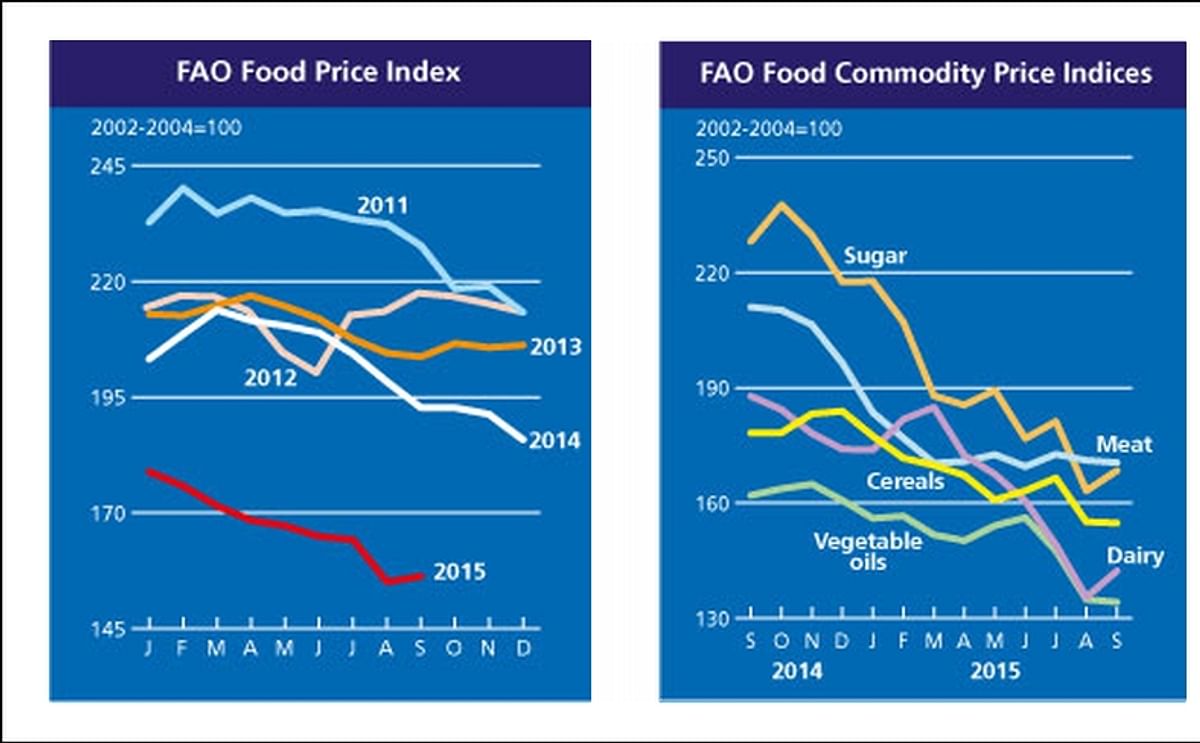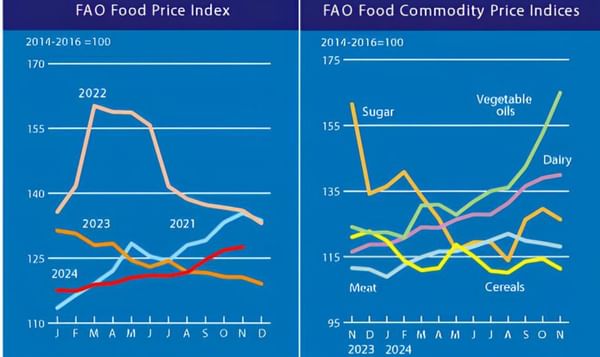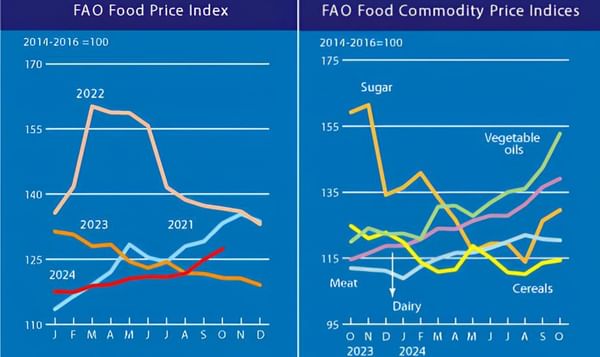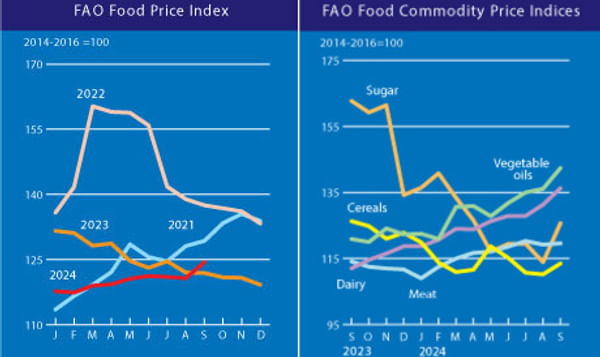The FAO Food Price Index including September 2015 (left) and the differences by food commodity category (right)
September FAO Food Price Index breaks downward trend, but only just.

The FAO Food Price Index averaged 156.3 points in September 2015, up one point from its sharply reduced August value, but still 18.9 percent less than one year ago. The quotations of sugar and dairy products firmed last month, while those of the other commodities remained close to, or slightly below, their respective August levels.
The FAO Cereal Price Index averaged 154.8 points in September, nearly unchanged from August and 13.1 percent down year-on-year. International cereal prices have been under downward pressure since the beginning of 2015, amid large inventories and generally good crop prospects.
Wheat is now over 20 percent cheaper than in September last year, following this season’s record production. Influenced by an expected decline in world maize production, coarse grains quotations have been more resilient, subsiding only 1.4 percent compared to September 2014. Despite prospects of crop shortfalls, rice quotations have continued to slide, albeit by only 1.7 percent in September, extending the declining trend to a thirtieth consecutive month.
The FAO Vegetable Oil Price Index averaged 134.2 points in September, marginally below the previous month (0.5 percent) but the lowest level since March 2009. The September fall was mainly driven by lower palm oil quotations, reflecting abundant export availabilities, especially in Malaysia where a weak currency is sustaining exports.
International soy oil prices also declined, on ample supplies in South America and a favourable 2015/16 global production outlook. Meanwhile, prices of rape and sunflowerseed oils increased somewhat on concerns about lower than anticipated global availabilities.
The FAO Dairy Price Index averaged 142.3 points in September, up 6.8 points (5 percent) from August. The rise followed a sharp fall in the Index in the previous month. While the prices of all dairy commodities firmed, those of milk powders exhibited the largest increase. This was associated mainly with higher quotations from New Zealand, where a substantial reduction in payouts has caused farmers to scale-back production.
The FAO Meat Price Index averaged 170.5 points in September, almost unchanged from the previous month. The Index has moved within a narrow range since March 2015. Over this seven-month period, prices of poultry declined, supported by lower feed costs, while strong demand, combined with limited supplies, caused those of bovine meat to rise; meanwhile, quotations for pigmeat were relatively stable. Prices of ovine meat showed more variation, in part reflecting seasonal supply.
The FAO Sugar Price Index averaged 168.4 points in September, up 5.2 points (3.2 percent) from August. The increase was largely weather driven, under the El Niño negative effects. In Brazil, the world´s largest sugar producer, excessive precipitation in the main producing region significantly curtailed sugarcane harvesting, while in India, the world´s second largest producer, below average monsoon rains impacted negatively on cane yields.
Similarly, official reports in Thailand, the world’s second largest sugar exporter, pointed to a smaller sugarcane harvest in 2015/16, as result of a protracted drought. Given current prospects for Brazil, India and Thailand, the anticipated production deficit in 2015/16 is likely to be wider than originally anticipated.
The FAO Cereal Price Index averaged 154.8 points in September, nearly unchanged from August and 13.1 percent down year-on-year. International cereal prices have been under downward pressure since the beginning of 2015, amid large inventories and generally good crop prospects.
Wheat is now over 20 percent cheaper than in September last year, following this season’s record production. Influenced by an expected decline in world maize production, coarse grains quotations have been more resilient, subsiding only 1.4 percent compared to September 2014. Despite prospects of crop shortfalls, rice quotations have continued to slide, albeit by only 1.7 percent in September, extending the declining trend to a thirtieth consecutive month.
The FAO Vegetable Oil Price Index averaged 134.2 points in September, marginally below the previous month (0.5 percent) but the lowest level since March 2009. The September fall was mainly driven by lower palm oil quotations, reflecting abundant export availabilities, especially in Malaysia where a weak currency is sustaining exports.
International soy oil prices also declined, on ample supplies in South America and a favourable 2015/16 global production outlook. Meanwhile, prices of rape and sunflowerseed oils increased somewhat on concerns about lower than anticipated global availabilities.
The FAO Dairy Price Index averaged 142.3 points in September, up 6.8 points (5 percent) from August. The rise followed a sharp fall in the Index in the previous month. While the prices of all dairy commodities firmed, those of milk powders exhibited the largest increase. This was associated mainly with higher quotations from New Zealand, where a substantial reduction in payouts has caused farmers to scale-back production.
The FAO Meat Price Index averaged 170.5 points in September, almost unchanged from the previous month. The Index has moved within a narrow range since March 2015. Over this seven-month period, prices of poultry declined, supported by lower feed costs, while strong demand, combined with limited supplies, caused those of bovine meat to rise; meanwhile, quotations for pigmeat were relatively stable. Prices of ovine meat showed more variation, in part reflecting seasonal supply.
The FAO Sugar Price Index averaged 168.4 points in September, up 5.2 points (3.2 percent) from August. The increase was largely weather driven, under the El Niño negative effects. In Brazil, the world´s largest sugar producer, excessive precipitation in the main producing region significantly curtailed sugarcane harvesting, while in India, the world´s second largest producer, below average monsoon rains impacted negatively on cane yields.
Similarly, official reports in Thailand, the world’s second largest sugar exporter, pointed to a smaller sugarcane harvest in 2015/16, as result of a protracted drought. Given current prospects for Brazil, India and Thailand, the anticipated production deficit in 2015/16 is likely to be wider than originally anticipated.
Like to receive news like this by email? Join and Subscribe!
Join Our Telegram Channel for regular updates!
精选企业
Sponsored Content
Sponsored Content
Sponsored Content
Sponsored Content
Sponsored Content











